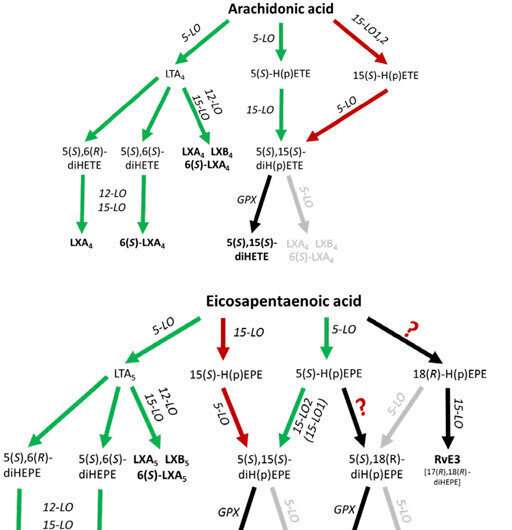
Inflammation is the result of an active defense reaction by our immune system. It mostly disappears by itself. It was once assumed to be a passive process because the immune cells involved, having done their work, gradually die off or migrate. Today, we know that our body also actively controls the resolution of inflammation. To this end, certain cells of the innate immune system, known as M1 macrophages, which are pro-inflammatory and in the first instance serve as a defense mechanism, transform into M2 macrophages, which are anti-inflammatory and primarily help to heal wounds.
In the past, the formation of specialized pro-resolving lipid mediators (SPMs) was considered an important molecular effect of this transformation. Since their discovery in 1984, they have given an ever-growing group of “resolutionists” worldwide reason to hope that it would one day be possible to intervene therapeutically in inflammatory processes by means of synthetic “inflammation resolvers” (resolvins).
The drugs against inflammation and its symptoms that are currently available—such as acetylsalicylic acid and COX-2 inhibitors—act, by contrast, as antagonists to certain arachidonic acid metabolism reactions, which generate pro-inflammatory tissue hormones. These include thromboxane and prostaglandins on the one hand and leukotrienes on the other. Only two metabolism steps away from arachidonic acid, those SPMs are also produced to which an anti-inflammatory effect has so far been attributed.
Indeed, a doctoral thesis in the Research Training Group “Resolution of inflammation—Mediators, signaling and therapeutic options” established at Goethe University in 2017 showed that the anti-inflammatory macrophages form the two enzymes needed to produce SPMs. However, only under non-physiological conditions—the researchers added stimulators that increased the calcium permeability of the macrophage membrane (ionophores)—could tiny amounts of SPMs be detected. Even when, as another study demonstrated, pre-treated substrates of these enzymes were added to cell cultures of certain white blood cells (neutrophilic leukocytes), these substrates were hardly converted to lipoxins and resolvins.
Further suspicion was triggered by earlier work on SPM receptors by Professor Stefan Offermanns, who, like Professor Dieter Steinhilber, is project leader in the Collaborative Research Center “Signaling by fatty acid derivatives and sphingolipids in health and disease” hosted by Goethe University. In his study, no effect of lipoxin A via the corresponding G protein-coupled receptor could be identified. Lipid mediators transmit their signals via these receptors. Moreover, in the blood plasma of healthy volunteers, SPMs could at best be found in the single-digit picogram range, even when using the most sensitive and selective methods (coupling of chromatography and mass spectrometry).
On the basis of these findings, Steinhilber’s research team combed through all the papers on SPMs published so far. This review endorsed their dismantling of the SPM concept: human leukocytes, to which macrophages also belong, can at best synthesize small amounts of SPMs. These amounts are so tiny that they cannot be reliably quantified even with state-of-the-art analytics. There is no correlation between SPM synthesis and the resolution of an inflammatory reaction nor with a targeted intake of polyunsaturated omega-3 fatty acids. To date, there is no valid evidence of functional SPM receptors.
“Insiders have known for a long time that the SPM concept was questionable,” says Steinhilber. “But until now no one has taken the trouble to gather all the doubts together.” There had to be another mechanism of active inflammation resolution, he says. “Because the transformation of pro-inflammatory M1 macrophages into anti-inflammatory M2 macrophages clearly goes hand in hand with a change in the lipid and cytokine profile.”
“The search for the molecular signals that our body uses to actively prevent excessive or chronic inflammation continues to be exciting,” says Professor Bernhard Brüne, Vice President of Goethe University and spokesperson for the Research Training Group. “It’s a source of motivation for our future research.”
Source: Read Full Article